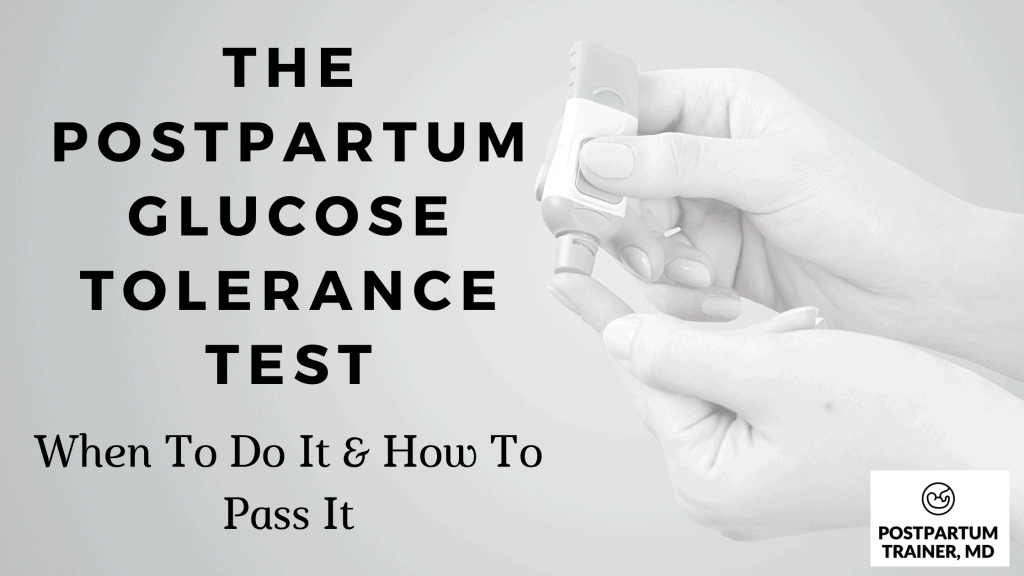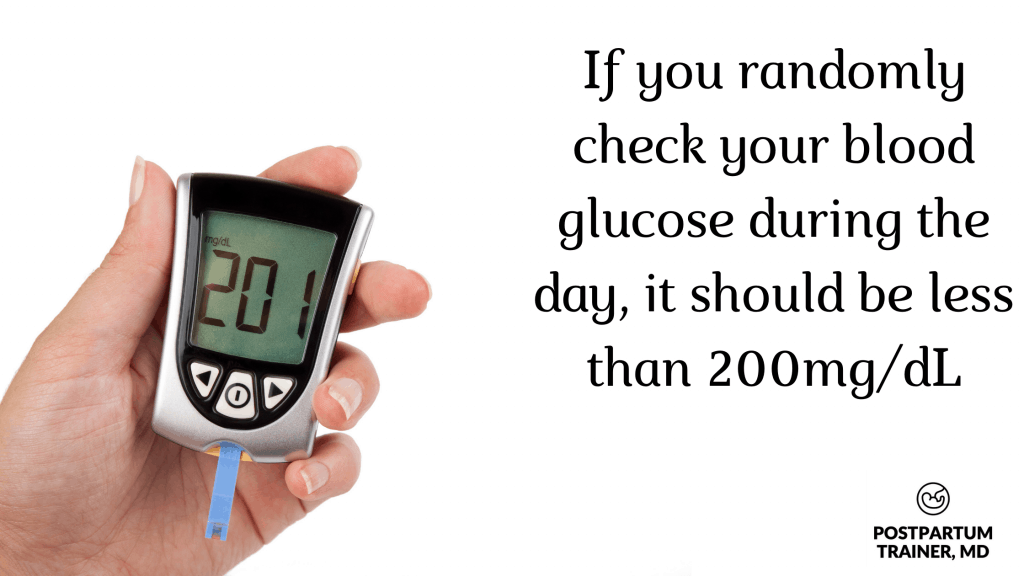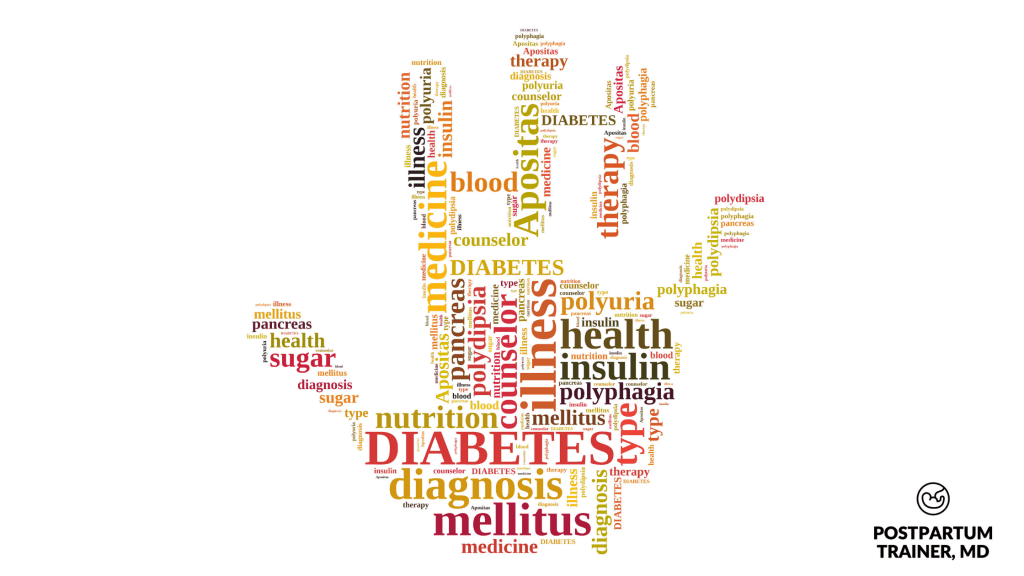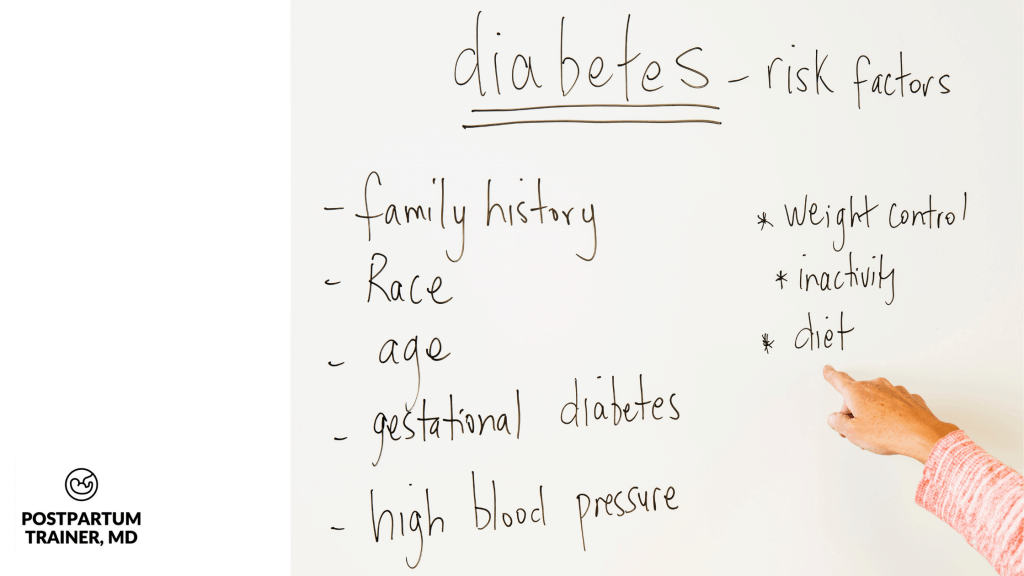Did you know that you have to take a postpartum glucose test if you had gestational diabetes?
In this post, you are going to learn:
- What happens after delivery if you had gestational diabetes,
- How long it will take for gestational diabetes to go away, and
- When and how to check if you still have diabetes in the postpartum.
Let’s get started!

What happens after birth if you have gestational diabetes?
The carbohydrate intolerance of gestational diabetes often resolves after delivery.
As a result, women with gestational diabetes are no longer screened nor given treatments for their blood sugar levels after giving birth.
However, some women will have persistently elevated blood sugar levels after delivery. That is why early postpartum is an excellent time to establish healthy life-long dietary habits.
In addition, you are at increased risk of developing postpartum hypertension, aka preeclampsia. If you develop severe headaches, visual disturbances, severe abdominal pain, or difficulty breathing after delivery, you should seek care immediately.
Be sure to follow up closely with your health care provider, as you will need testing for postpartum diabetes in a few weeks.
How long does it take for gestational diabetes to go away?
Typically, you can expect your blood sugar levels to return to your pre-gestational diabetes numbers within a few days of delivery. You no longer have a placenta in your body producing the hormone human placental lactogen (HPL).
HPL decreases the production of insulin by the action of your pancreas to allow your baby to get the nutrition it needs from your body.
However, you are not completely clear from the diagnosis until you pass the postpartum glucose test.
If you fail the test, you are now diagnosed with type II diabetes mellitus.
More on that later.
How do you manage gestational diabetes after giving birth?
After giving birth, you will no longer need to have your blood glucose level checked after every meal nor take insulin.
The best thing that you can do is continue to eat a well-balanced diet even though you are no longer considered a gestational diabetic. It may also be a good idea to check your blood glucose levels from time to time during the first few weeks postpartum.
In addition, engaging in regular physical activity can help control blood sugar levels and is an excellent supplemental treatment option for anyone with diabetes.
To learn more about safe exercises you could perform before six weeks, click here.
What are normal blood sugar levels after pregnancy?
A normal fasting glucose level (in the morning before eating) is less than 99mg/dL.
After eating a meal, a normal 2-hour postprandial blood glucose level should be less than 140mg/dL.
If you randomly check your blood sugar throughout the day, it should be less than 200mg/dL.

How do you check for gestational diabetes postpartum?
You will be screened for diabetes postpartum by performing a 2 hour, 75-gram oral glucose tolerance test (OGTT). Unfortunately, up to one-third of women will fail the diagnostic test due to poor glycemic control.
You will need to go to your doctor’s office fasting, meaning you cannot eat or drink anything.
Do your best to schedule this appointment first thing in the morning so you can get in and out quickly.
Once you arrive at your doctor’s office:
- You will have a fasting blood glucose test performed.
- Next, you will drink about 10 ounces of 75 grams of sugar.
- After, you will sit and wait for 2 hours.
- Then, you will have your blood glucose level checked.
If the blood glucose level is less than 140mg/dL, you passed and do not have diabetes.
If the blood glucose level is between 141mg/dL and 199mg/dL, you are classified as prediabetes and have a higher risk of developing type II diabetes mellitus if you don’t do anything about it.
If the blood glucose level is greater than 200mg/dL, you are now diagnosed with type II diabetes mellitus.
When do you do the glucose test postpartum?
The postpartum gtt is usually done 6-12 weeks after delivery, around the time of your comprehensive postpartum visit.
Try to schedule the postpartum gtt at the same times as your postpartum visit so that you can limit the number of times you have to go to the doctor’s office.
How do I pass the postpartum glucose tolerance test?
There is no guaranteed way to pass the postpartum glucose tolerance test. The best thing that you can do to increase your chances of passing is to follow a well-balanced diet that limits your intake of sugar and simple carbohydrates.
It is also important to note that postpartum screening is not a one-time event.
This needs to be a lifelong commitment to a healthy lifestyle. Your body has already demonstrated that it has some level of impaired glucose metabolism.
Regular exercise will also be an essential part of managing your blood glucose levels.
What happens if I fail the postpartum glucose test?
If you fail the postpartum glucose test, you will be referred to your primary care specialist for the life-long management of your diabetes.
In general, you will be encouraged to try several lifestyle modifications, including:
- Improving your diet and decreasing your intake of simple carbohydrates
- Weight loss through caloric restriction and improved nutrition
- Exercise for improvement in blood sugar uptake

Depending on how much insulin resistance you have (or if your hemoglobin A1C is very elevated), you may be started on medical therapy such as injectable insulin.
You can also be classified as a pre-diabetic if your levels don’t quite meet the criteria for full-blown diabetes, but are high enough to be of concern.
Can I breastfeed after the test?
Yes, you can breastfeed after glucose tolerance testing. As always, make sure that you adequately hydrate yourself as you may be dehydrated from the oral glucose load.
Does breastfeeding affect the postpartum glucose tolerance test?
If you can breastfeed, I highly encourage that you do so, as breastfeeding has also been shown to decrease your child’s risk of childhood obesity.
Anything else I should know?
Once you have been diagnosed with gestational diabetes in a prior pregnancy, you are at increased risk for developing it again in your next pregnancy.
As a result, you should be screened for gestational diabetes early in your prenatal care (in the first trimester) to get ahead of the condition.
In addition, the American College of Obstetricians and Gynecologists and The American Diabetes Association recommend that you have your glycemic status checked every 1-3 years.
Finally, if you are diagnosed with gestational diabetes, your child is at risk of developing obesity and type II diabetes mellitus later in life.
Other related questions
What are the two types of gestational diabetes mellitus?
There are two types of gestational diabetes.
- GDMA1 or diet-controlled gestational diabetes, and
- GDMA2 or medication-controlled gestational diabetes.
Usually, you will start out as GDMA1 when you are diagnosed with gestational diabetes.
If you cannot control your fasting blood glucose level (which should be less than 95mg/dL) and/or your 1-hour postprandial blood glucose level (which should be less than 140mg/dL) with diet and exercise alone, medication will be added, and you will be upgraded to GDMA2.
The medication of choice for GDMA2 is insulin therapy.
What risk factors increase the chances of developing postpartum diabetes?
You are at high risk of developing postpartum diabetes mellitus if you have any of the following:

- High body mass index (BMI) or excessive weight gain
- A first-degree relative(s)/strong family history of diabetes
- High-risk ethnicity (e.g., African American, Latino, Asian American)
- High blood pressure
- High cholesterol
- Polycystic ovarian syndrome (PCOS)
- Elevated Hb A1C (glycosylated hemoglobin)
- Physically inactive
- History of GDM
- Your blood sugar levels were poorly controlled during your pregnancy
Final Words on Postpartum Glucose Testing
The diagnosis of GDM should be taken very seriously as it can have many long-term effects in the future.
Gestational diabetes is a significant risk factor for developing type 2 diabetes mellitus and obesity in the future.
You must continue to eat a healthy diet and engage in an exercise routine in the postpartum period.
Now I have some questions for you.
Did you still have postpartum glucose intolerance?
How were you instructed to manage it?
Comment below and let me know!
Get Four Free Workouts To Help Strengthen Your Pelvic Floor & Heal Your Mommy Tummy!

Brittany Robles, MD, MPH, CPT
Brittany Robles is a full-time OBGYN physician, a NASM certified trainer, and a prenatal and postnatal fitness specialist. She holds a Master of Public Health degree in maternal health with a special interest in exercise and nutrition. She is also the co-author of The White Coat Trainer. Learn more about her here.
Sharing is Caring – Send This To A Mom In Need!
References:
- Cheung NW, Helmink D. Gestational diabetes: the significance of persistent fasting hyperglycemia for the subsequent development of diabetes mellitus. J Diabetes Complications. 2006 Jan-Feb;20(1):21-5. doi: 10.1016/j.jdiacomp.2005.05.001. PMID: 16389163.
- Kim C. Maternal outcomes and follow-up after gestational diabetes mellitus. Diabet Med. 2014;31(3):292-301. doi:10.1111/dme.12382
- ACOG Practice Bulletin 190: Gestational-Diabetes-Mellitus
- Gunderson EP, Crites Y, Chiang V, Walton D, Azevedo RA, Fox G, Elmasian C, Young S, Salvador N, Lum M, Hedderson MM, Quesenberry CP, Lo JC, Ferrara A, Sternfeld B. Influence of breastfeeding during the postpartum oral glucose tolerance test on plasma glucose and insulin. Obstet Gynecol. 2012 Jul;120(1):136-43. doi: 10.1097/AOG.0b013e31825b993d. PMID: 22914402; PMCID: PMC3427537.
- Tarrant M, Chooniedass R, Fan HSL, Del Buono K, Masina S. Breastfeeding and Postpartum Glucose Regulation Among Women With Prior Gestational Diabetes: A Systematic Review. J Hum Lact. 2020 Nov;36(4):723-738. doi: 10.1177/0890334420950259. Epub 2020 Sep 2. PMID: 32877291.
- Yan J, Liu L, Zhu Y, Huang G, Wang PP. The association between breastfeeding and childhood obesity: a meta-analysis. BMC Public Health. 2014;14:1267. Published 2014 Dec 13. doi:10.1186/1471-2458-14-1267

Hi. My son is now 20 months old, I had GDM when i was pregnant and I have not done the Postpartum glucose test yet. Can I still do the test now? Considering that you mentioned it is recommended to get it done within 6-12weeks postpartum. Would the result still be accurate? Thank you.
Hi Gil,
Thank you so much for your comment!
At this point it is probably best to follow up with your PCP and he or she can do a more traditional glucose test to determine if you have diabetes mellitus.
Hope this helps!